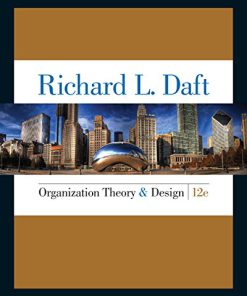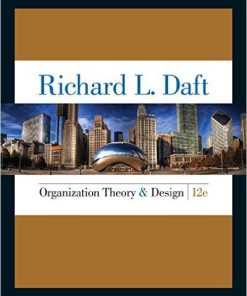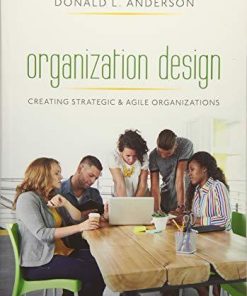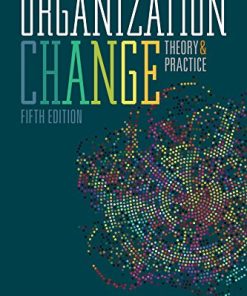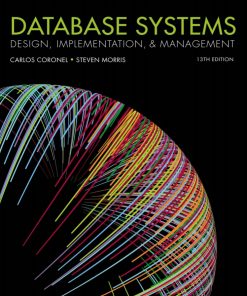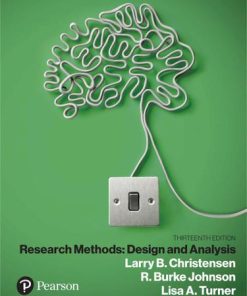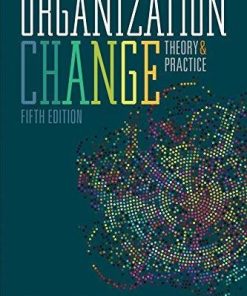Organization theory and design 13th Edition by Richard Daft 8214350042 9798214350042
$50.00 Original price was: $50.00.$25.00Current price is: $25.00.
Organization theory and design 13th Edition by Richard L. Daft – Ebook PDF Instant Download/DeliveryISBN: 8214350042, 9798214350042
Full download Organization theory and design 13th Edition after payment.
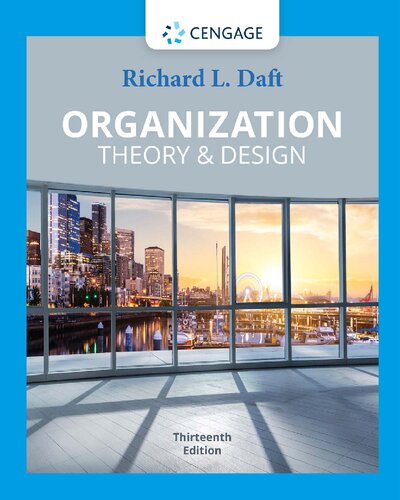
Product details:
ISBN-10 : 8214350042
ISBN-13 : 9798214350042
Author: Richard L. Daft
Introduce your students to the most progressive thinking about organizations today as acclaimed author Richard Daft balances recent, innovative ideas with proven classic theories and effective business practices. Daft’s best-selling ORGANIZATION THEORY AND DESIGN presents a captivating, compelling snapshot of contemporary organizations and the concepts driving their success. Recognized as one of the most systematic, well-organized texts in the market, the 13th edition of ORGANIZATION THEORY AND DESIGN helps current and future managers prepare for the challenges of today’s business world. The new edition features important revisions, including a new chapter on Designs for Social Impact: Dual-Purpose Organizations and a new chapter on Designs for Digital Organizations and Big Data. Other new topics include Reverse Innovation, Artificial Intelligence, Social Network Analysis and Holacracy Team-Based Structure. In addition, the text continues its tradition of incorporating the most current examples and research alongside time-tested principles. Students see how many of today’s well-known organizations have learned to cope and even thrive amidst a rapidly changing, highly competitive international environment. Featured organizations include Facebook, Uber, Amazon, Disney/Pixar, Southwest Airlines, Barnes & Noble, and Cisco Systems and dozens of other companies, many from other countries. Organization studies, proven cases, and illustrations provide the insights necessary to better understand modern organizations, while new and proven learning features give your students opportunities to apply concepts and refine their personal business skills and insights.
Organization theory and design 13th Table of contents:
Part 1. Introduction to Organizations
Chapter 1. Organizations and Organization Design
1.1. A Look inside General Electric
1.1a. The Jack Welch Era 1981–2001
1.1b. The Jeff Immelt Era 2001–2017
1.1c. Events since 2017
1.2. Organization Design in Action
1.2a. Topics
1.2b. Purpose of This Chapter
1.2c. Current Challenges
1.3. What Is an Organization?
1.3a. Definition
1.3b. From Multinationals to Nonprofits
1.3c. Importance of Organizations
1.4. Dimensions of Organization Design
1.4a. Structural Dimensions
1.4b. Contingency Factors
1.4c. Performance and Effectiveness Outcomes
1.5. The Evolution of Organization Design
1.5a. Historical Perspectives
1.5b. It All Depends: Key Contingencies
1.6. The Contrast of Organic and Mechanistic Designs
1.7. The Emerging Bossless Design Trend
1.8. Framework for the Book
1.8a. Levels of Analysis
1.8b. Plan of the Book
1.8c. Plan of Each Chapter
Key Concepts
Discussion Questions
Chapter 1 Workshop. Measuring Dimensions of Organizations
Case for Analysis. Craft Originalities, Inc.
Part 2. Organization Purpose and Structural Design
Chapter 2. Strategy, Organization Design, and Effectiveness
2.1. The Role of Strategic Direction in Organization Design
2.2. Organizational Purpose
2.2a. Strategic Intent
2.2b. Operating Goals
2.2c. Goal Conflict
2.2d. The Importance of Goals
2.3. Two Frameworks for Selecting Strategy and Design
2.3a. Porter’s Competitive Strategies
2.3b. Miles and Snow’s Strategy Typology
2.3c. How Strategies Affect Organization Design
2.3d. Other Contingency Factors Affecting Organization Design
2.4. Assessing Organizational Effectiveness
2.4a. Definition of Organizational Effectiveness
2.4b. Who Decides?
2.4c. Goal Approach
2.4d. Resource-Based Approach
2.4e. Internal Process Approach
2.4f. Strategic Constituents Approach
2.5. An Integrated Effectiveness Model
Indicators
Key Concepts
Discussion Questions
Chapter 2 Workshop. Identify Your Goal Preferences
Case for Analysis. The Addlington Gallery of Art
Case for Analysis. Millier Machine Parts & Services
Chapter 3. Fundamentals of Organization Structure
3.1. Organization Structure
3.2. Information-Sharing Perspective on Structure
3.2a. Centralized versus Decentralized
3.2b. Vertical Information Sharing
3.2c. Horizontal Information Sharing and Collaboration
3.2d. Relational Coordination
3.3. Organization Design Alternatives
3.3a. Required Work Activities
3.3b. Reporting Relationships
3.3c. Departmental Grouping Options
3.4. Functional, Divisional, and Geographic Designs
3.4a. Functional Structure
3.4b. Functional Structure with Horizontal Linkages
3.4c. Divisional Structure
3.4d. Geographic Structure
3.5. Matrix Structure
3.5a. Conditions for the Matrix
3.5b. Strengths and Weaknesses
3.6. Virtual Network Structure and Outsourcing
3.6a. How the Structure Works
3.6b. Strengths and Weaknesses
3.7. Holacracy Team Structure
3.7a. Characteristics
3.7b. Strengths and Weaknesses
3.8. Applications of Structural Design
3.8a. Mix and Match
3.8b. Structural Alignment
3.8c. Symptoms of Structural Deficiency
Key Concepts
Discussion Questions
Chapter 3 Workbook. You and Organization Structure
Case for Analysis. Holtzclaw Supermarkets, Inc.
Case for Analysis. Aquarius Advertising Agency
Part 3. Open System Design Elements
Chapter 4. The External Environment
4.1. The Organization’s Environment
4.1a. Task Environment
4.1b. General Environment
4.1c. International Environment
4.2. The Changing Environment
4.2a. Complexity
4.2b. Dynamism
4.2c. Framework
4.3. Adapting to Complexity and Dynamism
4.3a. Adding Positions and Departments
4.3b. Building Relationships
4.3c. Differentiation and Integration
4.3d. Organic versus Mechanistic Management Processes
4.3e. Planning, Forecasting, and Responsiveness
4.4. Framework for Adapting to Complexity and Dynamism
4.5. Dependence on Financial Resources
4.6. Influencing Financial Resources
4.6a. Establishing Formal Relationships
4.6b. Influencing Key Sectors
4.7. Organization–Environment Integrative Framework
Key Concepts
Discussion Questions
Chapter 4 Workshop. Organizations You Rely on
Case for Analysis. CPI Corporation
Case for Analysis. Farrington Medical Devices
Chapter 5. Interorganizational Relationships
5.1. Organizational Ecosystems
5.1a. Is Competition Dead?
5.1b. The Changing Role of Management
5.1c. Interorganizational Framework
5.2. Resource Dependence
5.2a. Types of Resource-Dependence Relationships
5.2b. Power Implications
5.3. Collaborative Networks
5.3a. Why Collaboration?
5.3b. From Adversaries to Partners
5.4. Population Ecology
5.4a. What Hinders Adaptation?
5.4b. Organizational Form and Niche
5.4c. Process of Ecological Change
5.4d. Strategies for Survival
5.5. Institutionalism
5.5a. The Institutional View and Organization Design
5.5b. Institutional Similarity
Key Concepts
Discussion Questions
Chapter 5 Workshop. The Shamatosi
Case for Analysis. Technomagia and AUD
Case for Analysis. Bradford Chemicals Company
Chapter 6. Designing Organizations for the International Environment
6.1. Entering the Global Arena
6.1a. Motivations for Global Expansion
6.1b. Managing the Stages of International Development
6.1c. Global Expansion through International Alliances and Acquisitions
6.2. The Challenges of Global Design
6.2a. Increased Complexity and Differentiation
6.2b. Increased Need for Coordination
6.2c. Transfer of Knowledge and Reverse Innovation
6.3. Designing Structure to Fit Global Strategy
6.3a. Strategies for Global versus Local Opportunities
6.3b. International Division
6.3c. Global Product Division Structure
6.3d. Global Geographic Division Structure
6.3e. Global Matrix Structure
6.4. Additional Global Coordination Mechanisms
6.4a. Global Teams
6.4b. Headquarters Planning
6.4c. Expanded Coordination Roles
6.4d. Benefits of Coordination
6.5. The Transnational Model of Organization
Key Concepts
Discussion Questions
Chapter 6 Workshop. Made in the U.S.A.?
Case for Analysis. Halogen Analytics
Case for Analysis. Rhinebeck Industrial
Chapter 7. Designs for Societal Impact: Dual-Purpose Organizations, Corporate Sustainability, and Ethics
7.1. Designing the Dual-Purpose Organization
7.1a. Facing the Challenge
7.1b. Designs for Achieving Dual Commercial and Social Welfare Goals
7.2. Corporate Social Responsibility
7.2a. The Green Movement
7.2b. The Triple Bottom Line
7.2c. Conscious Capitalism
7.2d. Serving Organizational Stakeholders
7.2e. Serving the Bottom of the Pyramid
7.3. The Consequences for Doing Good
7.4. Designing a Structure for Executing a Sustainability Program
7.4a. A Separate Department or Include Everyone?
7.4b. Involve External Stakeholders
7.4c. Set Goals, Measure, and Reward
7.5. Designs to Uphold Ethical Values
7.5a. Sources of Individual Ethical Principles
7.5b. Organizational Ethics
7.5c. Formal Structure and Systems
7.6. Corporate Ethics in a Global Environment
Key Concepts
Discussion Questions
Chapter 7 Workshop. What Is Your Level of Ethical Maturity?
Case for Analysis. Solo: Helping a Million People See Again
Case for Analysis. Fiedler, Philips & Wilson Design
Part 4. Internal Design Elements
Chapter 8. Designs for Manufacturing and Service Technologies
8.1. Core Manufacturing Technology
8.1a. Manufacturing Firms
8.1b. Strategy, Technology, and Performance
8.1c. The Smart Factory
8.1d. Mass Customization
8.1e. Performance and Structural Implications
8.2. Surviving Extremely Complex Technologies
8.2a. Extreme Technology Complexity
8.2b. High Reliability Organizing
8.3. Core Service Technology
8.3a. Service Firms
8.3b. Designing the Service Organization
8.4. Noncore Departmental Technology
8.4a. Variety
8.4b. Analyzability
8.4c. Framework
8.4d. Department Design
8.5. Workflow Interdependence among Departments
8.5a. Types
8.5b. Structural Priority
8.5c. Structural Implications
Key Concepts
Discussion Questions
Chapter 8 Workshop. Small Business Workflow Technology
Case for Analysis. Acetate Department
Case for Analysis. Digitalization in the Manufacturing Sector: Skills in Transition
Chapter 9. Designs for Digital Organizations and Big Data Analytics
9.1. The Digital Information Explosion
9.2. Pipes versus Platforms: A New Organization Form
9.2a. Two Types
9.2b. Foundational Assumptions
9.2c. Platform Design Recommendations
9.3. Big Data Analytics
9.3a. Big Data Requirements
9.3b. Big Data and Organization Structure
9.4. Artificial Intelligence
9.4a. Is Ai an Objective Decision Maker?
9.4b. Is Nudge Management Going to Be Your Coach?
9.4c. Algorithmic Control May Be Your New Boss
9.4d. Ai Implications for Organization Design
9.5. Other Digital Applications in Organizations
9.5a. Social Network Analysis
9.5b. Knowledge Management
9.6. Digital Impact on Organization Design
Key Concepts
Discussion Questions
Chapter 9 Workshop. Manufacturing and Big Data: Organize the Project
Case for Analysis. Hermitage Escalator Company
Chapter 10. Organization Size, Life Cycle, and Decline
10.1. Organization Size: Is Bigger Better?
10.1a. Pressures for Growth
10.1b. Dilemmas of Large Size
10.2. Organizational Life Cycle
10.2a. Stages of Life-Cycle Development
10.2b. Organizational Characteristics During the Life Cycle
10.3. Organizational Size, Bureaucracy, and Control
10.3a. What Is Bureaucracy?
10.3b. Size and Structural Control
10.4. Bureaucracy in a Changing World
10.4a. Organizing Temporary Systems
10.4b. Other Approaches to Busting Bureaucracy
10.5. Bureaucracy and Other Forms of Control
10.5a. Bureaucratic Control
10.5b. Market Control
10.5c. Clan Control
10.6. Organizational Decline
10.6a. Definition and Causes
10.6b. A Model of Decline Stages
Key Concepts
Discussion Questions
Chapter 10 Workshop. Classroom Control
Case for Analysis. Yahoo!: “Get to Work!”
Case for Analysis. Bachmeyer Foods, Inc.
Part 5. Managing Dynamic Processes
Chapter 11. Organizational Culture and Control
11.1. Organizational Culture
11.1a. What Is Culture?
11.1b. Emergence and Purpose of Culture
11.1c. Interpreting/Shaping Culture
11.2. Culture and Organization Design
11.2a. The Adaptability Culture
11.2b. The Achievement Culture
11.2c. The Clan Culture
11.2d. The Bureaucratic Culture
11.3. Culture Strength and Organizational Subcultures
11.4. Culture and Performance
11.5. The Cultural Focus of Control Systems
11.5a. The Changing Philosophy of Control
11.5b. Feedback Control Model
11.5c. Organization Level: The Balanced Scorecard
11.5d. Department Level: Behavior versus Outcome Control
Key Concepts
Discussion Questions
Chapter 11 Workshop. Balanced Scorecard Exercise
Case for Analysis. Midwest Controls, Inc.
Case for Analysis. Nascar
Chapter 12. Innovation and Change
12.1. The Strategic Role of Innovation
12.1a. Innovate or Be Disrupted
12.1b. Strategic Types of Innovation
12.2. Elements for Successful Change
12.3. Technology Innovation
12.3a. The Ambidextrous Approach
12.3b. The Bottom-Up Approach
12.3c. Techniques for Encouraging Technology Change
12.4. New Products and Services
12.4a. New Product Success Rate
12.4b. Reasons for New Product Success
12.4c. Horizontal Coordination Model
12.4d. Open Innovation and Crowdsourcing
12.4e. The Need for Speed
12.5. Strategy and Structure Change
12.5a. The Dual-Core Approach
12.5b. Organization Design for Implementing New Management Processes
12.6. Culture Change
12.6a. Forces for Culture Change
12.6b. Culture Change Interventions
12.7. Tactics for Implementing Change
12.7a. Leadership for Change
12.7b. Techniques for Implementation
12.7c. Techniques for Overcoming Resistance
Key Concepts
Discussion Questions
Chapter 12 Workshop. Innovation Climate
Case for Analysis. Fabulous Footwear
Case for Analysis. Lamprey, Inc.
Chapter 13. Decision-Making Processes
13.1. Types of Decisions
13.2. Individual Decision Making
13.2a. Rational Approach
13.2b. Bounded Rationality Perspective
13.3. Cognitive Biases
13.3a. Specific Biases That May Influence Decision Making
13.3b. Overcoming Cognitive Biases
13.4. Organizational Decision Making
13.4a. Management Science Approach
13.4b. Carnegie Model
13.4c. Incremental Decision Model
13.5. Organizational Decisions and Change
13.5a. Combining the Incremental and Carnegie Models
13.5b. Garbage Can Model
13.6. Contingency Decision-Making Framework
13.6a. Problem Consensus
13.6b. Technical Knowledge about Solutions
13.6c. Contingency Framework
13.7. Special Decision Circumstances
13.7a. High-Velocity Environments
13.7b. Decision Mistakes and Learning
Key Concepts
Discussion Questions
Chapter 13 Workshop. Style of Decision Making
Case for Analysis. Government DTS
Case for Analysis. Dubois French Eatery
Chapter 14. Conflict, Power, and Politics
14.1. Interdepartmental Conflict in Organizations
14.1a. Sources of Conflict
14.1b. Rational Versus Political Model
14.1c. Tactics for Enhancing Collaboration
14.2. Power and Organizations
14.2a. Individual Versus Organizational Power
14.2b. Power Versus Authority
14.2c. Vertical Sources of Power
14.2d. The Power of Empowerment
14.2e. Horizontal Sources of Power
14.3. Political Processes in Organizations
14.3a. Definition
14.3b. When to Use Political Activity
14.4. Using Soft Power and Politics
14.4a. Tactics for Increasing Power
14.4b. Political Tactics for Using Power
Key Concepts
Discussion Questions
Chapter 14 Workshop. How Do You Handle Conflict?
Case For Analysis. East Tennessee News
Case for Analysis. The Burlington Plant
Integrative Cases
Integrative Case 1.0. Disorganization at Semco: Human Resource Practices as a Strategic Advantage
Background Note
Organizational Strategy
Organizational Structure
Human Resource Practices—The Essence of Semco
Autonomy
Doing Only What Was Needed
Bottom-Up Approach
Leadership Earned
Transparency
Individual Driven
A Balanced Approach
Production Staff—Brothers in Partnership
Single-Minded Focus on Performance
Lessons in Surviving Economic Crises
Impact
Constraints to Replication?
Integrative Case 2.0. Walmart’s Failures in Entering Three Developed Markets
Germany
South Korea
Japan
Marketing
Price: Customer Cost
Product: Customer Solution
Merchandising Styles That Did Not Translate
Place: Convenience
Promotion: Communication
Summary of Findings
Sources
Integrative Case 3.0. IKEA: Scandinavian Style
Beginnings
Supplier Relationships
Mission and Culture
Current Challenges
Globalization
Behind the Curtain
The Future and India
Sources
Integrative Case 4.0. Engro Chemical Pakistan Limited—Restructuring the Marketing Division
Company Background
Culture
Need for Restructuring
Original Structure of the Marketing Division
Problems with the Original Setup
High Employee Turnover
Weak Market Development
Inventory Control
The Change Process
Implementation
Improvements
Increased Communication among Employees
Efficient Inventory Control
Greater Market Penetration and Exposure
Greater Job Satisfaction of Tier III Employees in Their New Role as AMMs
Quantitative Analysis
Concerns and Challenges
List of Acronyms Used
Integrative Case 5.0. The New York Times versus Amazon
The Letter to the Amazonians from Jeff Bezos
The Article That Sparked Controversy
Amazon’s Response to Criticism
The Birth of an Online Bookstore
Life as Amazon Sees It
References
Integrative Case 6.0. Lean Initiatives and Growth at Orlando Metering Company
Background
The Decision to Go Lean
Background on Lean Manufacturing
Becoming the Lean Showcase
Rapid Growth at OMC
Current State at OMC
Sources
Integrative Case 7.0. SCG Lampang: Overcoming Community Resistance to a Sustainability Project (A)
Check Dams and Water Preservation
Village Culture and Beliefs
Thailand’s Sufficiency Economic Philosophy
SCG’s Strong Culture and Values
Leadership Challenges
Integrative Case 8.0. Costco: Join the Club
No Frills
Valuing People
Design to Fit
New Issues
Sources
Integrative Case 9.0. The Donor Services Department
What Is a Donor Services Department in a Sponsorship Agency Anyway?
The Department Head
The Cast of Characters in the Department
The Supervisor
The Workers
Integrative Case 10.0. Cisco Systems: Evolution of Structure
Growth
Cisco 1
Cisco 2
Cisco 3
Corporate Culture
Corporate Sustainability
Further Developments
Sources
Integrative Case 11.0. ToolTopia.com
Introduction
Troy Stubblefield’s Story
Launching ToolTopia
Growing a Company
Changing Facilities
Shifting to a Virtual Workspace
A Chance to Sell the Business
Integrative Case 12.0. Sometimes a Simple Change Isn’t So Simple
Introduction
Background
The Rationale
The Project Team
MAR Project Development
Testing
Training
Reorganization
Implementation
People also search for Organization theory and design 13th:
richard l daft organization theory and design
daft rl 2015 organization theory and design
daft organization theory and design 13th edition
organization theory and design 13th edition free
organization theory and design 4th edition
Tags: Organization theory, design, Richard Daft, organizations, Richard Daft balances
You may also like…
Uncategorized
Business & Economics - Management & Leadership
Organization Theory & Design: An International Perspective 4th Edition Richard L. Daft
Computers - Databases
Database Systems: Design, Implementation, & Management 13th Edition
Business & Economics - Management & Leadership




